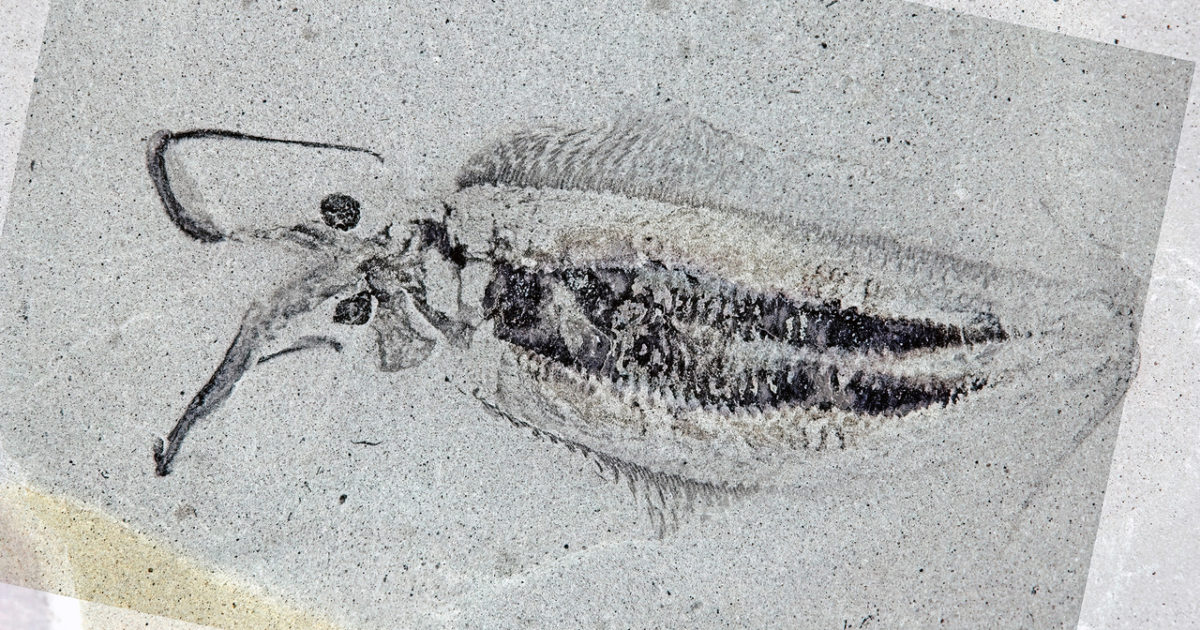 Paleontology
Paleontology
Fossil Friday: Nectocaris, the Impossible Squid

Nectocaris pteryx was described by the famous paleontologist Simon Conway Morris (1976) as a problematic animal of unknown affinity, based on a single poorly preserved fossil from the Cambrian Burgess Shale of the Canadian Rocky Mountains. For a long time this holotype fossil remained the only known specimen. Conway Morris speculated that it might be an arthropod. Rolfe (1981) indeed considered Nectocaris at a basal crustacean, and even though he did not bother to give any reasons for this allocation (Simonetta 1988) it was accepted by most subsequent publications. However, one study attributed Nectocaris to chordates and reconstructed from the same fossil an animal that looked like the modern lancelet Branchiostoma (Simonetta 1988). However, the author never studied the original fossil but only worked with photographs. Within thirty years after its original description many further specimens were found and deposited in museum collections.
Smith & Caron (2010) revised Nectocaris on the basis of 92 specimens and reconstructed the animal as a 2-3 inches long squid-like creature with two tentacles, two camera-type eyes, an axial cavity with gills, an anterior funnel, and a pair of lateral fins. Indeed, they attributed Nectocaris to molluscs, and more specifically as a basal cephalopod, which has significant and problematic implications for the evolution of this group. Mazurek & Zatoń (2011) strongly disagreed with this placement and instead considered Nectocaris as related to the soft-bodied stem-arthropod Anomalocaris. They interpreted the alleged two tentacles of Nectocaris as homologous to the paired cephalic appendages of Anomalocaris, the lateral eyes as its compound eyes, the alleged funnel as homologous to its round mouth-disk, and the lateral fins as homologous to its lateral row of flaps.
Contradicting Darwinian Expectations
This seems quite reasonable, but Smith & Caron (2011) rejected these similarities with anomalocarids as non-homologous, and instead defended their original attribution to cephalopods. Nevertheless, other studies (Kröger et al. 2011, Runnegar 2011) also strongly disputed the cephalopod nature (and even any molluscan affinity), because it is fundamentally in conflict with all other consensus knowledge about cephalopod evolution and character aquisition, and because the cephalopod-like interpretation of some body structures does not make sense (e.g., the funnel could not function as propulsion organ, and lateral fins could not evolve before the Carboniferous because all prior cephalopods had shells) (also see Macquarie University 2011).
A further major problem for a cephalopod interpretation was the absence of a genuine radula in Nectocaris, because this sclerotized feeding organ is distinctive for molluscs and is present in all known cephalopods without exception (Bengtson 2010). Not bothered by such problems, Smith (2013) presented a new study and even suggested that Nectocaris might be nested more deeply within cephalopods rather than being a stem-cephalopod, which would multiply the problems with the known fossil record of cephalopods. However, Smith (2019) placed nectocaridids as sister lineage to cephalopods (including the “monoplacophoran” stem group) and based his conclusions on the discovery of a new nectocaridid species (Nectocotis rusmithi) from the Late Ordovician of New York, which “possesses a robust internal element that resembles a non-mineralized phragmocone” and two denticulate chevrons at the base of the tentacles that might be homologous to a molluscan radula. The same author is currently supervising a PhD project about this very subject (Smith 2020). In the proposal Smith calls the identification as cephalopod a “controversial interpretation,” which “contradicts the conventional viewpoint of evolutionary ‘progress’ from sluggish forebears to ‘advanced’ modern taxa.” He also admits that if Nectocaris is not a cephalopod, it would be a “remarkable degree of convergence [which] implies that physical processes constrain biological possibility, with evolution only able to arrive at a finite number of discrete ‘body plans.’” So whatever Nectocaris should turn out to be, it seems to contradict Darwinian expectations.
A Temporal Paradox
There is another severe issue for an attribution of Nectocaris to cephalopods that is also endorsed by the Wikipedia (2022) article on Nectocaris: it is the fact that we have good evidence for cephalopods being phylogenetically nested within shelly molluscs (Sigwart & Sutton 2007), which implies that their ancestors should be shelly as well. The same holds for modern squids, which have secondarily reduced their shell (Strugnell & Nishiguchi 2007). There is indeed direct fossil evidence that cephalopods originated from shelly ancestors such as the Cambrian “monoplacophoran” Knightoconus (Yochelson et al. 1973, Kröger et al. 2011), very much unlike Nectocaris. Recently, there was even fossil evidence discovered for genuine shelly cephalopods from 522 milion year old deposits in Canada that are 14 million years older than Nectocaris from the Burgess Shale (Hildenbrand et al. 2021). That would create a temporal paradox of the assumed descendants being much older than the oldest assumed ancestors. Hildenbrand et al. therefore concluded that Nectocaris
lacks unequivocal molluscan characteristics, and other features even oppose an assignment to coleoids, such as the presence of lateral fins and camera-like eyes. The axial cavity and the funnel could not have served as jet-propulsion or respiratory systems in N. pteryx, due to their shapes. Nectocaris may therefore represent an independent group of Lophotrochozoa. The material described here clearly resembles a shelly cephalopod and thus contradicts an early Cambrian Nectocaris ancestry of cephalopods as well.
Based on the above mentioned new Nectocaris material from the Burgess Shale, Smith & Caron (2010) recognized that the enigmatic Early Cambrian organism Vetustovermis is clearly a nectocaridid, which makes all the results from the study of Vetustovermis relevant for the interpretation of Nectocaris as well. Glaessner (1979) had described Vetustovermis planus from the Early Cambrian Emu Bay Shale of Australia as a putative annelid worm. Luo et al. (1999) described similar fossils from the Lower Cambrian Chenggjiang fauna (Maotianshan Shale) in China under the name Petalilium and considered them as arthropods.
Based on 17 new specimens from this Chinese locality, Chen et al. (2005) recognized that the taxon Petalilium (erroneously misspelled Petalium by Chen et al.) is just an invalid synonym of Vetustovermis. They provided a redescription and new reconstruction that looks almost identical to the new reconstruction of Nectocaris by Smith & Caron (2010). They recognized the funnel-like structure as a digestive organ, which would contradict a cephalopod relationship. Based on another new specimen, Kröger et al. (2011) later came to exactly the same conclusion and rejected an interpretation as cephalopod-like funnel. Chen et al. (2005) mentioned similarities of Vetustovermis with flatworms, nemertines, and molluscs, but ultimately concluded that “all the characters displayed in this 525 million-year old soft-bodied animal fail to demonstrate clear affinity with molluscs or any other known extant or extinct animal groups, but argue for representing an independently evolved animal group.” The BBC News reports agreed that it is a “strange fossil [that] defies grouping” and possibly represents a new animal phylum (Kettlewell 2005).
Reason for Pause
It should definitely give some reason for pause that the very same fossil organism can be considered to be a “shrimp,” an anomalocarid stem arthropod, a chordate, an annelid, a new phylum of Lophotrochozoa, a stem cephalopod or a squid. And even more than a hundred very well-preserved specimens and the most modern research techniques have failed to resolve this controversy among the experts. Paleontology sometimes seems like a kind of imaginative Rorschach test with the flattened fauna of roadkill. When such dubious interpretations are celebrated as transitional forms and icons of evolution, some healthy skepticism is certainly appropriate. For the time being, Nectocaris is best considered as one of the enigmatic animal phyla originating in the Cambrian Explosion.
References
- Bengtson S 2010. Palaeontology: a little Kraken wakes. Nature 465, 427–428. DOI: https://doi.org/10.1038/465427a.
- Chen J-y, Huang D-y & Bottjer DJ 2005. An Early Cambrian problematic fossil: Vetustovermis and its possible affinities. Proceedings of the Royal Society B 272(1576), 2003–2007. DOI: https://doi.org/10.1098/rspb.2005.3159.
- Conway Morris S 1976. Nectocaris pteryx, a new organism from the Middle Cambrian Burgess Shale of British Columbia. Neues Jahrbuch für Geologie und Paläontologie Monatshefte 12, 703–713.
- Glaessner MF 1979. Lower Cambrian Crustacea and annelid worms from Kangaroo Island, South Australia. Alcheringa 3(1), 21–31. DOI: https://doi.org/10.1080/03115517908565437.
- Hildenbrand A, Austermann G, Fuchs D, Bengtson P & Stinnesbeck W 2021. A potential cephalopod from the early Cambrian of eastern Newfoundland, Canada. Communications Biology 4:388, 1–11. DOI: https://doi.org/10.1038/s42003-021-01885-w.
- Kettlewell J 2005. Strange fossil defies grouping. BBC News August 17, 2005. http://news.bbc.co.uk/2/hi/science/nature/4156544.stm
- Kröger B, Vinther J & Fuchs D 2011. Cephalopod origin and evolution: A congruent picture emerging from fossils, development and molecules. BioEssays 33(8), 602–613. DOI: https://doi.org/10.1002/bies.201100001.
- Luo H-L, Hu S-X & Chen L-Z 1999. Early Cambrian Chengjiang fauna from Kunming region, China. Yunnan Science & Technology Press, Kunming (China).
- Macquarie University 2011. Cambrian calamari: Is Nectocaris an ancestral cephalopod? pp. 19–20 in: BIOL261 Palaeontology (3 CP) BIOL809 Applied Palaeontology (4 CP). Internal Unit Outline 2nd semester, 2011. Department of Biological Sciences, Faculty of Science, Macquarie University, Sydney (NSW).
- Mazurek D & Zatoń M 2011. Is Nectocaris pteryx a cephalopod? Lethaia 44(1), 2–4. DOI: https://doi.org/10.1111/j.1502-3931.2010.00253.x.
- Rolfe WDI 1981. Phyllocarida and the origin of the Malacostraca. Geobios 14(1), 17–27. DOI: https://doi.org/10.1016/S0016-6995(81)80164-7.
- Runnegar BN 2011. Once again: is Nectocaris pteryx a stem-group cephalopod? Lethaia 44(4), 373. DOI: https://doi.org/10.1111/j.1502-3931.2011.00296.x.
- Sigwart JD & Sutton MD 2007. Deep molluscan phylogeny: synthesis of palaeontological and neontological data. Proceedings of the Royal Society B 274(1624), 2413–2419. DOI: https://doi.org/10.1098/rspb.2007.0701.
- Simonetta AM 1988. Is Nectocaris pteryx a chordate? Bollettino di Zoologia 55(1-4), 63–68. DOI: https://doi.org/10.1080/11250008809386601.
- Smith MR 2013. Nectocaridid ecology, diversity, and affinity: early origin of a cephalopod-like body plan. Paleobiology 39(2), 297–321. DOI: https://doi.org/10.1666/12029.
- Smith MR 2019. An Ordovician nectocaridid hints at an endocochleate origin of Cephalopoda. Journal of Paleontology 94(1), 64–69. DOI: https://doi.org/10.1017/jpa.2019.57.
- Smith MR 2020. PhD: Convergence or cryptic evolution? The origins of the cephalopod body plan. The Palaeontological Association. https://www.palass.org/careers/phd-opportunity/phd-convergence-or-cryptic-evolution-origins-cephalopod-body-plan
- Smith MR & Caron J-B 2010. Primitive soft-bodied cephalopods from the Cambrian. Nature 465, 469–472. DOI: https://doi.org/10.1038/nature09068.
- Smith MR & Caron J-B 2011. Nectocaris and early cephalopod evolution: reply to Mazurek and Zatoń. Lethaia 44(4), 369–372. DOI: https://doi.org/10.1111/j.1502-3931.2011.00295.x.
- Strugnell J & Nishiguchi MK 2007. Molecular phylogeny of coleoid cephalopods (Mollusca: Cephalopoda) inferred from three mitochondrial and six nuclear loci: a comparison of alignment, implied alignment and analysis methods. Journal of Molluscan Studies 73(4), 399–410. DOI: https://doi.org/10.1093/mollus/eym038.
- Wikipedia 2022. Nectocaris. https://en.wikipedia.org/wiki/Nectocaris
- Yochelson EL, Flower RH & Webers GF 1973. The bearing of the new Late Cambrian monoplacophoran genus Knightoconus upon the origin of the Cephalopoda.” Lethaia 6(3), 275–309. DOI: https://doi.org/10.1111/j.1502-3931.1973.tb01199.x.
